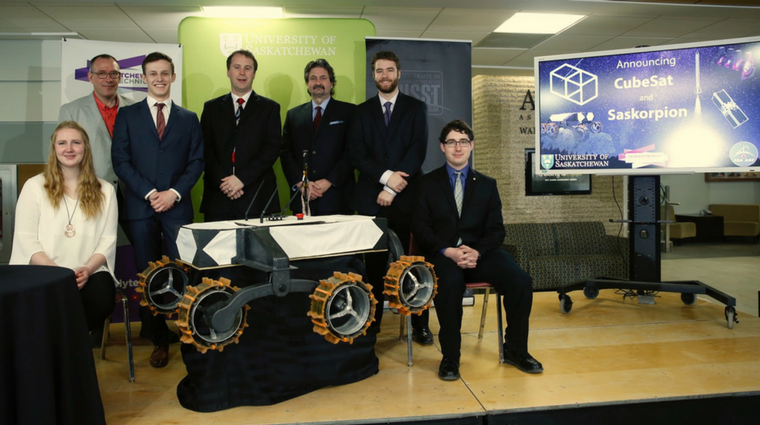
May 4, 2018 - In what will be Saskatchewan's first student-designed satellite mission, a University of Saskatchewan-led space design team has been chosen by the Canadian Space Agency (CSA) to design, build, launch and operate a small cube-shaped research satellite for launch by rocket in 2022.
The announcement was made today via teleconference by Canadian astronaut Jennie Sidey at a national event in Winnipeg that involved members of 15 successful teams.
As well, members of the U of S space design team recently learned that their Mars rover prototype (a space exploration vehicle) has been chosen to compete in the finals of the highly competitive 2018 University Rover Challenge in Utah this June. Their robotic rover "Saskorpion" (which has features that resemble a scorpion) ranked in the top five out of 98 competitors.
"We're delighted to support these talented students in carrying out these exciting, collaborative, and hands-on space science projects," said Karen Chad, USask Vice-President Research. "USask has a proud history of research and training success in space and atmospheric science, and the skills our students will develop during these unique projects will enable them to enter Canada's workforce with exemplary training, experience and passion for discovery and innovation."
A multi-disciplinary team involving more than 40 USask students from engineering,
computer science, physics and business, as well as several students from Saskatchewan
Polytechnic (Sask Polytech), has been awarded $200,000 in the CubeSat competition.
The CSA will also cover costs associated with the CubeSat space launch. USask, Saskatchewan
Polytechnic, and companies in the private sector such as SED Systems and Innocorp
Research Corporation are also providing cash or in-kind support, and crowdsourcing
is an option being explored.
"This funding is transformative for a group of brilliant students who have done an
exceptional job of multidisciplinary collaboration and mentoring of junior team members,"
said USask College of Engineering Dean Suzanne Kresta. "They truly have put Canada
on the map among an elite international group of students and universities."
The USask satellite will involve two 10cm X 10cm X 10cm cubes attached together—roughly
the size of two Rubik's cubes. Once tested, the tiny satellite will be launched as
cargo on a rocket from a North American or European space centre and then be deployed
from the International Space Station into space for a year to study how materials—ranging
from ceramics to space suit fabrics—degrade in space.
"We are very excited to partner with Sask Polytech on this initiative that will encourage
teamwork and mentorship from CSA and space industry experts and help develop and train
Canada's next generation of space science researchers and engineers," said Sean Maw,
lead investigator and holder of the Jerry Huff Chair in Innovative Teaching in the
College of Engineering.
The project will look at how potentially useful construction materials are affected
by extreme temperatures, radiation, and space debris in low Earth orbit, said co-lead
investigator Doug Degenstein, professor of engineering physics.
"The students will study material changes in colour, texture, brittleness, and electrical
conductivity. The results of the study could lead to more cost-efficient solutions
for the space sector," said Degenstein who is lead researcher for the satellite instrument
OSIRIS (Optical Spectrograph and InfraRed Imager System) that was CSA's contribution
to the multi-national Odin space mission.
Jamie Hilts, dean of both Sask Polytech's School of Mining, Energy and Manufacturing
and its School of Natural Resources and Built Environment, highlighted the fact that
the project provides Sask Polytech students with an opportunity to collaborate, problem
solve and build relationships with peers from USask.
"Building a satellite is an exceptional applied learning experience," Hilts said.
"Sask Polytech is excited to contribute our CAD/CAM expertise to the success of this
project."
Simone Hagey, a USask physics student who is one of three student managers for the
satellite project, is excited to have the opportunity to access space as an undergraduate
student. It's anticipated that there will be 40 to 60 students involved from across
campus, she said.
"I am very excited about the scale of this – it's a huge group of people, and learning
to manage that many people over several years will be a great opportunity," she said.
Founded in 2005, the U of S space design team has won several international awards
for innovations that include developing space elevators, rovers, rocket payloads,
and materials science microgravity experiments.
Over the past four years, more than 30 undergraduates have been working on the Saskorpion
rover that holds promise for search and rescue work, autonomous navigation, equipment
servicing, mapping/surveying, and astrobiology investigation.
Saskorpion, the team's largest (1.25 meters by 1.25 meters) yet lightest rover to
date, uses 3D and 360-degree cameras, enabling the rover to track objects in all directions
when operating autonomously and giving operators a virtual reality experience.
"We are excited to evaluate the robot for work on Mars by testing it in the Mars Desert
Research Station in Utah in June," said Danno Peters, president of the USask space
design team.

